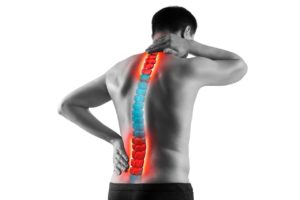Request Appointment
Enter your details and we will be in touch with you shortly;
Or call
8655885566
between 8 am and 8 pm.


The shoulder blades, also called the scapulae, are the two irregular triangular bones of the shoulder region. These bones are essential as they play a significant role in facilitating essential upper body movement by acting as a connecting link between the upper arm and breast bone. However, each of them is connected with three muscular sets that facilitate the movement of the shoulder joint. An injury, strain or damage to any of these muscles brings pain under and around the blades in the shoulder range. Shoulder blade pain or interscapular pain causes are one of the most common types of back pains, which you feel between your shoulder blades; it may be constant sharp, sudden throbbing pain in the shoulders or near the spine scapula.
In most cases, this is not a problem, though constant pain in the scapula can also point to the presence of a musculoskeletal disorder that may affect the mobility of the arm and back areas. To effectively manage and alleviate pain relating to the shoulder blade, there has to be one way or the other to know what may be causing it. With that in mind, we will now take a look at five causes of shoulder pain and go into detail regarding a few treatments related to scapula pain relief.
Let’s discuss the most common causes of pain under or around shoulder blades. It can be categorized into various segments-

Poor posture is undeniably one of the most common scapular pain causes. Sitting in a slouched or awkward position for extended periods can place the upper back, spinal discs, muscles, and ligaments under stress. This, in turn, may lead to sharp discomfort beneath the shoulder blades. This pain may be caused by an extended period of slouching or bending your upper back, having your head tilted down too far, or sitting in a crooked position to one side.

Trauma, either from lifting heavy weights or from direct blows to the area, is another leading cause of pain under the shoulder blade. Heavy weightlifting beyond a person’s capacity and without proper technique may lead to strained muscles and ligaments around the shoulder blade that might be painfully hurt. This injury usually occurs in people who are into high-impact exercises without proper training and conditioning. The fracture of the scapula through a fall or other means could also be another contributing factor to Scapular muscle pain and mobility problems of the shoulder blade.

Pain under the shoulder blade may be linked to several heart conditions. According to one study, heart conditions, such as those with aortic dissection, might allow individuals to experience discomfort in the shoulder area. Aortic dissection is the tearing of the inner wall of the aorta, which is the largest artery attached to the heart. This type of injury presents intense pain and may radiate to other body parts, including the scapula. These are often accompanied by chest pains, difficulty breathing, and dizziness. If your shoulder blade pain comes with these kinds of symptoms, make sure to get medical attention immediately, as it could be a symptom of a complication that could easily cost you your life.


Structural conditions such as cervicothoracic scoliosis or a dislocated rib can also cause Scapular area pain. The bending of the spine, in the case of cervicothoracic scoliosis, puts additional unusual stress on muscles and joints around the shoulder blade. This condition occurs when a rib becomes misaligned due to repetitive pressure or injury, leading to pain that radiates to the shoulder blade. The rib might also be dislocated and cause sharp pains under the shoulder blade, especially with physical activities, even to the extent of breathing. This often happens when the ribs are misaligned, which can be brought on by trauma or repetitive strain that puts pressure on the region and sends discomfort radiating to the shoulder blade.
Diagnosing the cause of shoulder pain requires a thorough examination by a physician. It usually begins with an interaction in which the physician explores whether the cause of the shoulder pain is trivial. If a cause cannot be determined, the doctor may consider further examinations, which may include the following:
Self-care, physical therapy, and sometimes medical intervention are required to get shoulder blade pain relief. Following are some methods that will relieve pain under a shoulder blade:
It is also recommended that you consult a doctor if you have sprained your shoulder. A doctor may recommend other forms of treatments or therapies that can help in healing.
Certain symptoms require urgent medical attention, including:
Seek immediate medical care if you experience any of these warning signs. The sooner the treatment for some potentially life-threatening conditions is begun, the better.
Pain under the shoulder blade has various possible causes, including posture, injury, structural conditions, and overall health. Various cases of scapula pain often settle with self-care and home remedies, but for persistent or severe pain, it’s important to visit a doctor. Once you understand the causes of shoulder blade pain and receive appropriate treatment, you will be able to achieve scapula pain relief and improve your overall quality of life.
If you are experiencing pain behind your shoulder blade or have other concerns about your spine health, visit QI Spine and consult with a doctor. Our doctors will manage your problem comprehensively and treat various spine disorders effectively, ensuring you get interscapular pain relief and regain your normal mobility.Visit our nearest clinic for your first consultation
A shoulder blade pain is concerning when it is persistent, gets worse, or presents with symptoms such as chest pain, shortness of breath, or numbness towards the lower part. Interscapular pain or persistent soreness in the scapula may indicate a potentially fatal underlying condition.
A pillow that supports the spine correctly when lying down, sleeping on the back, or under the knees may reduce some pressure off the scapula and, in turn, relieve the pain of the shoulder blade.
The symptoms of scapula pain might range from mild discomfort to a more significant underlying issue. Therefore, in order to diagnose the problem and take the appropriate action, it is crucial to get medical help if the discomfort in the scapular area persists or gets worse.
The discomfort in the shoulder blades can be present for several days or even a few weeks, depending on the cause. Proper treatment, such as rest, physical therapy, and posture correction, can help get shoulder blade pain relief quickly and prevent the recurrence of discomfort.
Some possible ways to loosen a tight scapula quickly are to try some gentle stretches, shoulder rolls, and hot or cold therapy applied directly to the area of the scapular. Regularly doing this will have a significant impact on relieving shoulder blade pain and reducing Shoulder blade stiffness effectively.
Yes, stress can cause shoulder blade pain by leading to muscle tension, stiffness, and poor posture. Stress triggers the body’s fight-or-flight response, causing muscles—especially in the neck, shoulders, and upper back—to tighten, leading to discomfort and pain.
You should see a doctor if your shoulder blade pain is severe, persistent, or worsens over time. QI Spine’s doctors can help diagnose the root cause of your pain and provide effective non-surgical solutions for long-term relief.